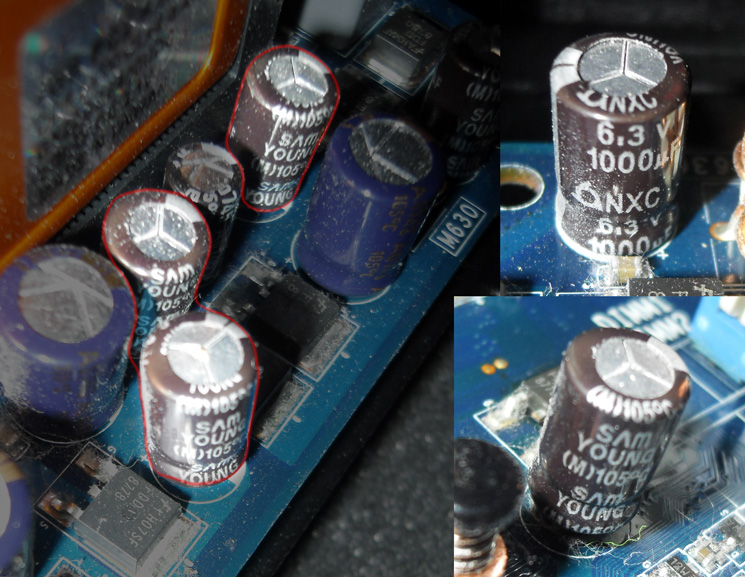I have a (relatively old) Abit IP35 board with a Q9650 and 8GB RAM that I was hoping could do some service for years to come still.
Everything is working fine at the moment, but when inspecting the board I can see quite a few caps that show every sign of going or being bad. There's only one type/size that show any visual degradation, but it's used loads of places on the board. Many have bulged tops, and 2-3 have dropped electrolyte in the bottom.

They seem to be 1000uF and 6,3V, and the make is Sam Young(?) from what I can read.
There will be quite a lot of soldiering to replace all of them, I haven't counted them yet but it's somewhere around 20. Is this one of the terrible ones so that all should be replaced, or should I take a chance and only change those with visual deformations?
The cost isn't the issue, I'm more worried about the time it will take me. My "tin suction thing" is some cheap chinese thing that really doesn't do the job very well and spend more time jamming than sucking. I haven't been able to find a decent one locally, and it's hard to judge their quality by a photo on a web shop. If any of you have a tip for a good one, I guess replacing all would go pretty quick.
Also, looking in the master list here on badcaps.net I can only find one that seems to match (article number 131):
This cap seems to be unavailable. I'm measuring the existing ones to be about 8,3mm in diameter and 13-14mm high. I don't think the 10mm diameter ones will fit, as some of these are in some tight spots.
Any and all suggestions/feedback are appreciated.
Everything is working fine at the moment, but when inspecting the board I can see quite a few caps that show every sign of going or being bad. There's only one type/size that show any visual degradation, but it's used loads of places on the board. Many have bulged tops, and 2-3 have dropped electrolyte in the bottom.
They seem to be 1000uF and 6,3V, and the make is Sam Young(?) from what I can read.
There will be quite a lot of soldiering to replace all of them, I haven't counted them yet but it's somewhere around 20. Is this one of the terrible ones so that all should be replaced, or should I take a chance and only change those with visual deformations?
The cost isn't the issue, I'm more worried about the time it will take me. My "tin suction thing" is some cheap chinese thing that really doesn't do the job very well and spend more time jamming than sucking. I haven't been able to find a decent one locally, and it's hard to judge their quality by a photo on a web shop. If any of you have a tip for a good one, I guess replacing all would go pretty quick.
Also, looking in the master list here on badcaps.net I can only find one that seems to match (article number 131):
1000uF 6.3v Nichicon HM 8mm 13mm
Any and all suggestions/feedback are appreciated.

Comment